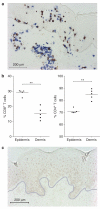CD8(+) T cells in the lesional skin of atopic dermatitis and psoriasis patients are an important source of IFN-γ, IL-13, IL-17, and IL-22
- PMID: 23223131
- PMCID: PMC3835628
- DOI: 10.1038/jid.2012.456
CD8(+) T cells in the lesional skin of atopic dermatitis and psoriasis patients are an important source of IFN-γ, IL-13, IL-17, and IL-22
Abstract
Although CD4(+) T cells are known to contribute to the pathology of atopic dermatitis (AD) and psoriasis, the role of CD8(+) T cells in these diseases remains poorly characterized. The aim of this study was to characterize the cytokine production of T cells from AD and psoriasis skin. We found that CD4(+) T cells isolated from AD skin were largely Th2 (T helper type 2) biased, in agreement with prior reports. However, we also observed large numbers of CD8(+) T cells producing IL-13, IFN-γ, and IL-22. We observed increased numbers of CD8(+) T cells isolated from AD skin, and immunohistochemistry studies confirmed the presence of CD8(+) T cells in the dermis and epidermis of AD skin lesions. Surprisingly, T-cell cytokine production was similar in the lesional and nonlesional skin of patients with AD. T cells from psoriatic lesional skin predominantly produced IFN-γ, IL-17, and IL-22, in agreement with prior studies. However, in addition to Th17 cells, we observed high percentages of CD8(+) T cells that produced both IL-22 and IL-17 in psoriatic skin lesions. Our findings demonstrate that CD8(+) T cells are a significant and previously unappreciated source of inflammatory cytokine production in both AD and psoriasis.
Figures




References
-
- Akdis CA, Akdis M, Simon D, et al. T cells and T cell-derived cytokines as pathogenic factors in the nonallergic form of atopic dermatitis. J Invest Dermatol. 1999;113:628–634. - PubMed
-
- Boniface K, Bernard FX, Garcia M, et al. IL-22 inhibits epidermal differentiation and induces proinflammatory gene expression and migration of human keratinocytes. J Immunol. 2005;174:3695–3702. - PubMed
-
- Clark RA, Chong BF, Mirchandani N, et al. A novel method for the isolation of skin resident T cells from normal and diseased human skin. J Invest Dermatol. 2006;126:1059–1070. - PubMed
-
- Conrad C, Boyman O, Tonel G, et al. Alpha1beta1 integrin is crucial for accumulation of epidermal T cells and the development of psoriasis. Nat Med. 2007;13:836–842. - PubMed
Publication types
MeSH terms
Substances
Grants and funding
LinkOut - more resources
Full Text Sources
Other Literature Sources
Medical
Research Materials

